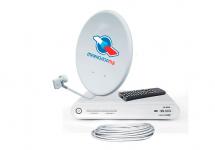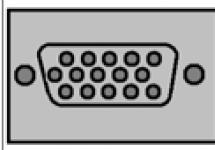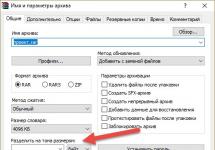For full-fledged video communication on Skype, you will need additional equipment, as well as some skills in connecting it. How to connect a Skype camera to a computer is not a complicated instruction at all; even a person who has never done this before can follow it.
Instructions
You can connect your webcam to your computer for Skype as follows:
- Find a free USB port on your PC. Typically, such connectors are located directly on the system unit, so there should be no problems
- Look at the lower left corner of the screen. If the computer sees additional equipment, it will immediately notify you about it. You will also hear a characteristic signal
- The main thing in connecting a video camera for Skype to a computer is installing drivers. Without them, new equipment will not work. Very often, the operating system itself finds the necessary drivers and installs them. In this case, you will see a notification about the successful connection of the device, which will appear in the lower left corner of the screen. If this does not happen, there are two options - download the “firewood” from the installation disk or flash drive or download it from the website of your webcam manufacturer
- Installing drivers also does not contain anything complicated - it is not much different from installing any downloaded program. All you have to do is follow the instructions of the “installer wizard”
- You can check the driver status by opening “Device Manager” (located in the “Start” menu), and then “Imaging devices”.
- A signal that something is wrong will be the absence of the name of your webcam in the list or the presence of a yellow triangle, exclamation or question mark next to it.
- After installing the drivers, you can connect the camera in the Skype program itself. Open the messenger and find the three dots at the top of the screen. Clicking on them will open the menu
- In the menu you need to find and open the “Sound and Video Settings” tab. You can set up a webcam on Skype here.
- A list of devices will open from which you need to select the one that will work by default. Find the name of your webcam in the list and click on it
- Now you can test your new equipment by making a trial video call by calling the Echo / Sound Test Service assistant, who is already included in your contact list
You can see how to complete these steps in the video:
Connection problems
Why can't my camera connect to Skype? Let's name a few of the most common reasons.
- In first place in popularity is the problem with drivers. If you download them yourself, be careful not to confuse the device models, which sometimes differ by one or two characters

- Make sure you are using the latest version of Skype. If this is not the case, install the update. Here there are complete instructions on what you need to do, everything is detailed and clear.

- The problem may also be with the USB port. If the computer does not see the webcam, we recommend trying to insert it into a different connector
- Can be . Only a service center specialist can verify this.
You will find all the answers to the question in our next article.
How to connect a camera to Skype on a laptop? Yes, exactly the same, because a laptop is the same computer, only more mobile. Additionally, most laptops have a webcam built-in.
Many gadget owners often wonder how to set up a webcam on their computer. There are many different problems that prevent it from functioning correctly:
- the device is simply not configured;
- drivers are missing, outdated or damaged;
- it works, but not as expected.
Main types of web cameras
Before setting up a webcam on a laptop, let’s consider what types there are:
- external. Purchased separately and attached to the monitor. Requires driver installation.
- built-in Most often present in laptops. Look carefully at the center of the top panel of your laptop monitor and you will see its peephole.
Depending on the type of device, their settings are made on the computer. For example, web cameras for home communication are mainly configured via Skype, but special software is provided for monitoring.
Installing an external web camera
An external web camera is a separate device that needs to be connected to an external peripheral port of the computer. Often we are talking about a PC USB port. Most of this equipment is universal and can work with any system. External web cameras often have a built-in microphone and a switch located directly on the body.
When purchasing equipment, you may find a CD or DVD with installation drivers included. To connect it you will need to perform a few simple steps:
- the camera is connected to a USB port;
- turns on using a button on the case;
- a disc with software is inserted;
- drivers are being installed.

Using the software, you will be able to set parameters for filming, as well as turn on and off various options using a computer. For example, you can adjust the microphone volume and, if necessary, set a password for protection.
Separately, you should read the article about.
Some models use plug&play technology, which makes it possible to avoid installing drivers manually. After the webcam is connected to the laptop and turned on, Windows will recognize the required driver and make the settings automatically.
What to do if the device is not detected
Quite often a situation arises when everything seems to be done correctly, the drivers are installed, but the equipment still does not work. In this case, reinstalling or updating them will come to your aid.
Reinstalling drivers will require the following procedures:


Setting up in Skype
Here we will take a closer look at how to set up a webcam on Skype and what steps you need to take:

Troubleshooting color problems - options
In order to adjust color rendering on your computer, you will need to perform the following simple steps.
The easiest and most affordable way to organize a video surveillance system is to connect a USB camera to your computer. Naturally, such a solution has minimal functionality, but is quite suitable for home use.
It’s worth noting right away that using such equipment for professional surveillance (with clear requirements for technical characteristics and safety level) is unacceptable.
There are two options for organizing video surveillance via USB:
- analog equipment connected via a USB converter;
- classic USB digital cameras (WEB-camera, “webcam”).
In the first case, special equipment is used - a USB converter, which is a compact video recorder (video capture card with a USB interface). Depending on the converter model, you can connect from 1 to 4 analog video cameras to the device.
However, recording a signal from several cameras simultaneously is usually impossible due to limitations imposed by the hardware of the equipment.
The advantages of the converter include compact size, easy installation and configuration, as well as full compatibility with computers and laptops running the Windows operating system. The main disadvantages are limited functionality and low image quality compared to full-fledged DVRs.
Classic USB cameras allow you to organize video surveillance in just a few minutes. There are a large number of models on the market. Preference is given to modern equipment with HD resolution (1280×720 pixels) and a built-in microphone. You can use cheaper cameras with a resolution of 0.3 megapixels, but the image quality will be below average.
There are models on sale with built-in infrared illumination for shooting in the dark. As a rule, IR illumination turns on automatically (a light sensor is located on the equipment body). The main advantages of digital USB cameras are low price, easy connection and a very wide range of models.
Flaws:
- minimal functionality;
- installation restrictions (cable length - no more than 5 m;
- for larger values it is necessary to use a special signal amplifier).
SOFTWARE FOR USB CAMERAS
To implement video surveillance based on USB video cameras, you must install the appropriate software on your PC. Most digital USB cameras and converters are sold with a disc containing drivers and software. Also, a minimum set of utilities can be downloaded from the manufacturer’s website.
Software for the converter is usually included in the package. Thus, the popular EasyCAP002 DVR converter model is designed to work with the Super Viewer program. The software allows you to quickly switch between connected cameras, set up timed recording, take screenshots and save video files to the hard drive of your computer or laptop.
Most of these programs have a simple and intuitive interface, so setting up and operating the equipment does not cause difficulties for inexperienced users.
For video surveillance using digital USB cameras, as a rule, third-party software is used, which significantly expands the functionality of even the simplest models. There are both paid and free versions of the programs. Paid software usually has a larger set of features.
Popular programs:
- WebcamXP is one of the most popular programs. The main advantages are flexible settings, compatibility with almost all camera models, and the ability to use a motion sensor to send alerts by email.
- Mobile Computer Control – built-in recording scheduler, motion detector, ability to remotely control a computer via a mobile phone.
- Xeoma – does not require installation (can be launched from a memory card), supports all types of cameras, motion detector, alert mode.
- Ivideon Server is an interesting solution with cloud video surveillance capabilities. If the PC is not connected to the Internet, you can only use the client program to save the video to your hard drive.
All of the above programs were created as accessible analogues of specialized software for security systems. And they are mainly used for organizing simple home video surveillance. Also, such software is often installed by owners of small retail outlets to monitor employees and customers.
The Ivideon Server program is especially in demand, allowing you to organize remote video surveillance via the Internet based on simple USB cameras.
HOW TO CONNECT A CCTV CAMERA TO USB
The digital camera (“webcam”) is already equipped with a standard USB connector for connecting to a computer or laptop. Most video cameras are designed for the USB 2.0 standard. However, models with high-resolution matrices, up to 10 megapixels (for example, Logitech HD Pro Webcam C920), which work better when connected via USB 3.0, are gaining popularity.
High data transfer speed allows you to realize all the benefits of high image resolution. It is worth considering that saving video files in high resolution requires much more space on your hard drive.
After connecting the device, you need to install drivers (usually included or available on the manufacturer’s website) and software of your choice.
Connecting the converter is also not particularly difficult. Almost all models connect to a USB 2.0 connector. To connect analog video cameras, the device is equipped with standard composite RCA (tulip) connectors. Video connectors are yellow, audio connectors are white. The converter can be connected either directly or via a regular USB extension cable.
The system requirements for a laptop or computer are minimal, so you can use hardware that is outdated for modern games or programs (processor from 1.8 GHz, RAM - 256 Mb, video card - 32 Mb).
After connecting the device, the driver and software are installed. For converters, it is recommended to use the included software.
Possible problems:
- No picture – the device is not recognized by the operating system. The solution is to reinstall the drivers.
- The camera works intermittently, the image freezes, etc. The solution is to check the quality of the USB connection. If an extension cord is used, you need to check the camera's functionality without it (signal attenuation may occur).
In general, a video surveillance system based on USB equipment is quite reliable, while special attention is paid to the technical condition of the computer or laptop.
A properly connected webcam to a PC allows you to record videos or communicate with other people on the Internet. In this article, we will talk about the connection process and subsequent testing of such a device.
Despite the variety of webcams, the process of connecting and further using them is not much different.
Step 1: Preparation
At the stage of choosing a webcam, you need to find out in advance which USB interfaces are present on your computer and purchase a compatible device.

If the camera is not equipped with a microphone, you will have to purchase and connect a device to record audio separately. Otherwise, the camera will only transmit a video signal.

When connecting a webcam with a built-in microphone, a jack may be required "3.5 mm jack" appropriate purpose.

Once you have completed checking the compatibility of your PC and webcam, you can proceed to the connection.
Step 2: Connection
The process of connecting a webcam to a computer is the simplest step, as it has many similarities with connecting most other peripheral devices. Moreover, the instructions are fully relevant if you are using a laptop.

If the connection is successful, you will receive a sound alert and the process can be considered complete.
Step 3: Software Installation
Some webcam models, in addition to connection, also require the installation of special software that comes with the device. Typically, the necessary drivers and software are installed automatically from optical media.

You can automatically update drivers for your webcam using DriverPack Solution or DriverMax.

If the specifications of your camera do not indicate software requirements, its installation is not required.
Step 4: Check
After connecting and installing special software, it is important to check the functionality of the device. We described this process using Windows 7 as an example, but the instructions are quite relevant for other versions of the OS.

Step 5: Setup
If the webcam, after connecting and testing, does not transmit the image as you would like, you can configure it. To change the parameters, you will need special software, be it the included software or Skype.

Webcam settings are also present in many programs designed for video recording.

A webcam is an absolutely indispensable thing for many modern personal computer users. With the help of a webcam, people now communicate on the Internet using video calling, shoot videos, take photos without leaving their PC. If desired, the webcam can also be used for video surveillance.
Webcams are connected to computers using a USB interface. This connector is known to any, even the most inexperienced, PC user; it is used to connect flash drives to a computer.

Such a connector can be located on the rear and/or front panel of the computer system unit. Basically, to connect a webcam to a computer, you just need to insert the camera’s USB cable into any of the connectors. There is no need to install drivers or any additional programs. Windows will automatically find and install everything you need. If someone plans to use their webcam constantly, then it is best to connect it via the USB connector on the back of the computer. And if from time to time you want to be able to quickly turn it off, then you can use the connector on the front panel.
So, we repeat, to connect the webcam to the computer, you just need to plug its cable into any of the USB connectors. The computer will make a specific sound, telling us that it has “seen” a new device. Next, you simply wait for a message to appear indicating that your device is completely ready for use.
Many video cameras come with microphones already built into them. Therefore, to the previous USB cable, a 3.5 mm mini-jack cable is added, which must be connected to the corresponding connector.
If the webcam “refuses” to work when connected to a PC, it means that it requires the installation of drivers, which are usually supplied on a CD included with the camera. Open this disk yourself and install the driver. If there is no disk with drivers (for example, lost), then you can download the appropriate driver from the official website of the webcam manufacturer.


